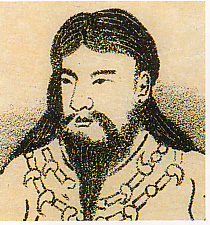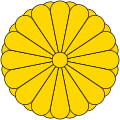
Emperor Suizei, also known as Kamununakawamimi no Mikoto (神沼河耳命), was the second legendary emperor of Japan according to the traditional order of succession. Very little is known about this Emperor due to a lack of material available for further verification and study. Suizei is known as a "legendary emperor" among historians as his actual existence is disputed. A legendary account from the Kojiki states that Suizei became emperor after receiving the title of crown prince by his half brother due to his bravery regarding a murder plot. Suizei's reign started in 581 BC, he had one wife and a sole son who supposedly became the next emperor upon his death in 549 BC.

Emperor Annei, also known as Shikitsuhikotamatemi no Mikoto (師木津日子玉手見命) was the third legendary emperor of Japan, according to the traditional order of succession. Very little is known about this Emperor due to a lack of material available for further verification and study. Annei is known as a "legendary emperor" among historians as his actual existence is disputed. Nothing exists in the Kojiki other than his name and genealogy. Annei's reign allegedly began in 549 BC, he had one wife and three sons. After his death in 511 BC, his second or third son supposedly became the next emperor.

Emperor Kōshō, also known as Mimatsuhikokaeshine no Mikoto (真津日子訶恵志泥命) was the fifth legendary emperor of Japan, according to the traditional order of succession. Very little is known about this Emperor due to a lack of material available for further verification and study. Kōshō is known as a "legendary emperor" among historians as his actual existence is disputed. Nothing exists in the Kojiki other than his name and genealogy. Kōshō's reign allegedly began in 475 BC, he had one wife and two sons. After his death in 393 BC, his second son supposedly became the next emperor.

Emperor Kōan, also known as Yamatotarashihikokunioshihito no Mikoto (大倭帯日子国押人命) was the sixth legendary emperor of Japan, according to the traditional order of succession. Very little is known about this Emperor due to a lack of material available for further verification and study. Kōan is known as a "legendary emperor" among historians as his actual existence is disputed. Nothing exists in the Kojiki other than his name and genealogy. Kōan's reign allegedly began in 393 BC, he had one wife and two sons and reigned for more than 100 years until his death in 291 BC at the age of 137. One of his sons then supposedly became the next emperor. Emperor Kōan is traditionally accepted as the final emperor of the Jōmon period, which ended in 300 BC.

Emperor Kōrei, also known as Ōyamatonekohikofutoni no Mikoto (大倭根子日子賦斗邇命) was the seventh legendary emperor of Japan, according to the traditional order of succession. Very little is known about this Emperor due to a lack of material available for further verification and study. Kōrei is known as a "legendary emperor" among historians as his actual existence is disputed. Nothing exists in the Kojiki other than his name and genealogy. Kōrei's reign allegedly began in 290 BC. He had one wife and three consorts with whom he fathered seven children. After his death in 215 BC, one of his sons supposedly became the next emperor. Kōrei is traditionally accepted as the first emperor of the Yayoi period, which is named after the Yayoi people who migrated to the Japanese archipelago from mainland Asia.

Emperor Kaika, also known as Wakayamato Nekohiko Ōbibi no Mikoto (若倭根子日子大毘毘命) in the Kojiki, and Wakayamato Nekohiko Ōbibi no Sumeramikoto (稚日本根子彦大日日天皇) in the Nihon Shoki was the ninth legendary emperor of Japan, according to the traditional order of succession. Very little is known about this Emperor due to a lack of material available for further verification and study. Kaika is known as a "legendary emperor" among historians as his actual existence is disputed. Nothing exists in the Kojiki other than his name and genealogy. Kaika's reign allegedly began in 158 BC. He had one wife and three consorts whom he fathered five children with. After his death in 98 BC, one of his sons supposedly became Emperor Sujin.

Emperor Suinin, also known as Ikumeiribikoisachi no Sumeramikoto (活目入彦五十狭茅天皇) was the 11th legendary Emperor of Japan, according to the traditional order of succession. Less is known about Suinin than his father, and likewise he is also considered to be a "legendary emperor". Both the Kojiki, and the Nihon Shoki record events that took place during Suinin's alleged lifetime. This legendary narrative tells how he ordered his daughter Yamatohime-no-mikoto to establish a new permanent shrine for Amaterasu, which eventually became known as the Ise Grand Shrine. Other events that were recorded concurrently with his reign include the origins of Sumo wrestling in the form of a wrestling match involving Nomi no Sukune.

Emperor Ōjin, also known as Hondawake no Mikoto (誉田別尊) or Homuta no Sumeramikoto (譽田天皇), was the 15th Emperor of Japan, according to the traditional order of succession. Both the Kojiki, and the Nihon Shoki record events that took place during Ōjin's alleged lifetime. Ōjin is traditionally listed as the first emperor of the Kofun period, and is primarily known for being the controversial son of Empress Jingū. Historians have mixed views on his factual existence, if Ōjin was indeed a historical figure then it's assumed he reigned much later than he is attested.

Yamatohime-no-mikoto is a Japanese figure who is said to have established Ise Shrine, where the Sun Goddess, Amaterasu Omikami is enshrined. Yamatohime-no-mikoto is recorded as being the daughter of Emperor Suinin, Japan's 11th Emperor.

Takenouchi no Sukune (武内宿禰) or Takeshiuchi no Sukune was a legendary Japanese hero-statesman of the 1st century, and a Shinto kami.

Emperor Itoku, also known as Ōyamatohikosukitomo no Mikoto (大倭日子鉏友命) was the fourth legendary Emperor of Japan, according to the traditional order of succession. Very little is known about this emperor due to a lack of material available for further verification and study. Itoku is known as a "legendary emperor" among historians as his actual existence is disputed. Nothing exists in the Kojiki other than his name and genealogy. Itoku's reign allegedly began in 510 BC, he had one wife and two sons. After his death in 477 BC, his first son supposedly became the next emperor.
Kibitsu-hiko-no-mikoto (吉備津彦命), also known as Hiko Isuseri-hiko no mikoto, was a legendary Japanese prince.
Isuzuyori-hime was the legendary empress consort of Japan as the wife of Emperor Suizei, the second legendary emperor of Japan. She was the mother of Emperor Annei. According to historical records, she is regarded as the ancestor goddess of the Masters of Shiki.
Kuwashi-hime no Mikoto, the empress of Emperor Kōrei. She is believed to be the birth mother of Emperor Kōgen.
Yosotarashi-hime no Mikoto, also known as Yosotarashi Hime or Onakatumi no Hime, is a figure in Japanese mythology who appears in the Kojiki, an ancient chronicle of Japan. She is said to have been the empress of Emperor Kōshō, the fifth emperor of Japan, and the sister of Okitsu Yoso, an ancestor of the Owari clan.

Princess Nakatsu, also known as Nakatsu-hime no Mikoto, is a figure in Japanese mythology who was the consort of Emperor Ōjin and the mother of Emperor Nintoku.
Ikagashikome was a concubine of Emperor Kōgen, and later Emperor Kaika and mother of Emperor Sujin.

Saho-hime (狭穂姫命) was the legendary empress consort of Japan from 28 BC to 25 BC.
Mimaki-hime (御間城姫) was the legendary empress consort of Japan from 97 BC to 29 BC, and then empress dowager from 29 BC according to traditional dates.
Nunasokonakatsu-hime (渟名底仲媛命) was the legendary empress consort of Japan from 546 to 510 BC and then empress dowager from 510 BC according to traditional dates.















